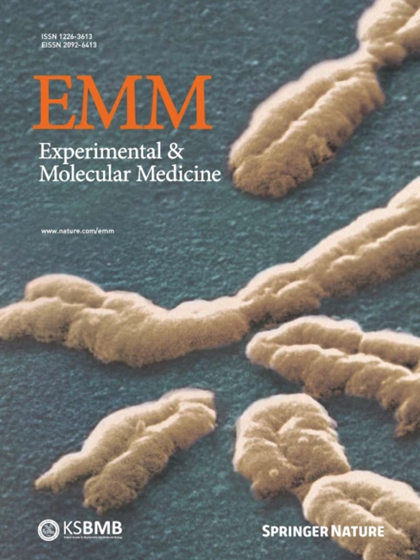在患者来源的iPSCs中,通过缺口酶将功能增强的FVIII基因整合到AAVS1位点,长期纠正血友病A
IF 9.5
2区 医学
Q1 BIOCHEMISTRY & MOLECULAR BIOLOGY
引用次数: 0
摘要
血友病A (HA)是由凝血因子VIII (FVIII)突变引起的。基因组编辑与患者来源的诱导多能干细胞(iPSCs)相结合是一种很有前途的细胞治疗策略,因为它用正常蛋白质取代了基因突变导致的功能失调蛋白质。然而,FVIII的低表达水平和短半衰期仍然是这些方法治疗HA疗效的重要限制因素。在这里,我们构建了一个功能增强的FVIII变体,F309S/ e1984v突变的B结构域删除(BDD)-FVIII (FE-FVIII),具有更高的活性和稳定性。我们通过CRISPR/Cas9 (D10A)缺口酶将带有人延伸因子-1 α (EF1α)启动子的FE-FVIII插入HA患者来源的iPSCs的AAVS1位点,以确保在任何细胞类型中表达。FE-FVIII不仅在未分化的FE-FVIII插入(FE-KI) ipsc中表达,而且在体外分化的内皮细胞(ECs)中也表达。与移植含bdd -FVIII野生型ECs的小鼠相比,静脉移植FE-KI ECs的免疫活性HA小鼠血液中FVIII活性增加2.12倍,出血性尾损伤后存活率提高约20%。为了获得持续的疗效,将FE-KI ECs皮下移植到免疫缺陷的HA小鼠中,结果血友病表型改善超过3个月。该策略可以改善FVIII功能,并可能为治疗HA提供通用的治疗方法。血友病A是一种遗传性疾病,由于X染色体上有缺陷的基因而导致出血。研究人员探索了一种利用干细胞和基因编辑来改善治疗的新方法。他们使用了从HA患者身上提取的诱导多能干细胞,这种干细胞可以变成任何类型的细胞。通过用CRISPR/Cas9编辑这些细胞,他们将修改后的缺陷基因插入到DNA的安全位置。这项研究包括实验室实验和对小鼠的测试,以观察编辑过的细胞是否能更有效地产生必要的蛋白质,因子VIII。改良后的FVIII具有较好的活性和稳定性。用这些细胞治疗的小鼠损伤后血液凝固和存活率有所提高。研究人员得出结论,这种方法可能是朝着更好地治疗HA迈出的有希望的一步。本摘要最初是使用人工智能起草的,然后由作者进行修改和事实核查。本文章由计算机程序翻译,如有差异,请以英文原文为准。

Long-term correction of hemophilia A via integration of a functionally enhanced FVIII gene into the AAVS1 locus by nickase in patient-derived iPSCs
Hemophilia A (HA) is caused by mutations in coagulation factor VIII (FVIII). Genome editing in conjunction with patient-derived induced pluripotent stem cells (iPSCs) is a promising cell therapy strategy, as it replaces dysfunctional proteins resulting from genetic mutations with normal proteins. However, the low expression level and short half-life of FVIII still remain significant limiting factors in the efficacy of these approaches in HA. Here, we constructed a functionally enhanced FVIII variant, F309S/E1984V-mutated B domain-deleted (BDD)-FVIII (FE-FVIII), with increased activity and stability. We inserted FE-FVIII with a human elongation factor-1 alpha (EF1α) promoter into the AAVS1 locus of HA patient-derived iPSCs via CRISPR/Cas9 (D10A) nickase to ensure expression in any cell type. FE-FVIII was expressed not only in undifferentiated FE-FVIII-inserted (FE-KI) iPSCs but also in endothelial cells (ECs) differentiated from them in vitro. Compared with mice transplanted with wild-type BDD-FVIII-containing ECs, immunocompetent HA mice intravenously transplanted with FE-KI ECs presented a 2.12-fold increase in FVIII activity in the blood and an approximately 20% greater survival rate after hemorrhagic tail injury. For sustained efficacy, FE-KI ECs were subcutaneously transplanted into immunodeficient HA mice, resulting in amelioration of the hemophilia phenotype for more than 3 months. This strategy can improve FVIII function and may provide a universal therapeutic approach for treating HA. Hemophilia A is a genetic disorder that causes bleeding due to a faulty gene on the X chromosome. Researchers explored a new approach using stem cells and gene editing to improve treatment. They used induced pluripotent stem cells, which can become any cell type, from HA patients. By editing these cells with CRISPR/Cas9, they inserted a modified version of the faulty gene into a safe spot in the DNA. This study involved lab experiments and tests on mice to see if the edited cells could produce the necessary protein, Factor VIII, more effectively. The modified FVIII showed better activity and stability than the regular version. Mice treated with these cells had improved blood clotting and survival rates after injury. The researchers concluded that this method could be a promising step toward better treatments for HA. This summary was initially drafted using artificial intelligence, then revised and fact-checked by the author.
求助全文
通过发布文献求助,成功后即可免费获取论文全文。
去求助
来源期刊

Experimental and Molecular Medicine
医学-生化与分子生物学
CiteScore
19.50
自引率
0.80%
发文量
166
审稿时长
3 months
期刊介绍:
Experimental & Molecular Medicine (EMM) stands as Korea's pioneering biochemistry journal, established in 1964 and rejuvenated in 1996 as an Open Access, fully peer-reviewed international journal. Dedicated to advancing translational research and showcasing recent breakthroughs in the biomedical realm, EMM invites submissions encompassing genetic, molecular, and cellular studies of human physiology and diseases. Emphasizing the correlation between experimental and translational research and enhanced clinical benefits, the journal actively encourages contributions employing specific molecular tools. Welcoming studies that bridge basic discoveries with clinical relevance, alongside articles demonstrating clear in vivo significance and novelty, Experimental & Molecular Medicine proudly serves as an open-access, online-only repository of cutting-edge medical research.
 求助内容:
求助内容: 应助结果提醒方式:
应助结果提醒方式:


